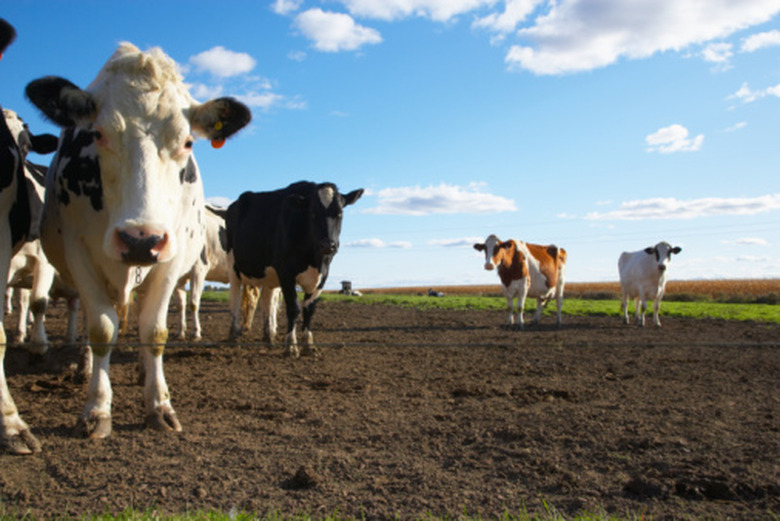The Difference Between The Human Digestive System & The Digestive System Of A Cow
The cow digestive system is not at all like the human digestive system. The main difference between the human digestive system and the cow's animal digestive system is simple: Cows have a stomach that consists of four compartments, commonly referred to as four stomachs. Cows spend the better part of the day eating, swallowing and regurgitating their food, and chewing it again before final digestion. Because a cow's teeth mostly grind their food, cows use their tongues – which is why they are so long – to help them gather and grasp grass for pinching off between their incisors and dental pad at the front part of their mouths.
TL;DR (Too Long; Didn't Read)
The ruminant stomach system in a cow lets it consume and swallow its food, storing it in the first two compartments of the stomach for later regurgitation and more thorough chewing.
The Ruminant Stomach of Cows
The Ruminant
Stomach of Cows
The main difference between man and cow – besides having two more legs and eating only grass – lies in the cow's stomach. Cows have a ruminant system with four distinctive sections: the rumen, the reticulum, the omasum and the abomasum, while humans have a monogastric stomach with one chamber. The cow digestive system allows herbivores to graze and consume grass until they are full. The uneaten grass goes into the rumen and the reticulum sections. Later the cow coughs up – regurgitates – a bit of the grass called cud to chew it again. Being coarse, grass does not break down easily in the stomach, which is why cows have a digestive system that allows them to regurgitate their cud to chew it more thoroughly before it enters the last two stomach sections, the omasum and the abomasum, for final digestion
Difference Between Cow and Human
Difference
Between Cow and Human
Cows belong to a class of animals called ruminants, which includes cloved hoofs, the ruminant stomach and a different set of teeth and mouth construction. As herbivores, cows require a lot of fiber in their diet, which they get from grazing. Their mouths contain 32 teeth, with six incisors and two canines on the bottom front met by a dental pad atop the mouth — which allows them to clip and consume a lot of grass. The canines in a cow's mouth behave more like incisors, being non-fang like, to cut the grass. A large gap exists in the cow's mouth to separate the front teeth and dental pad from the molars used when grinding the cud side-to-side.
Herbivores Eat Only Vegetation
Herbivores
Eat Only Vegetation
Herbivores belong to the classification of animals that eat only vegetation. This class of animal includes all grazers – cattle, horses, sheep, goats, antelope, zebra and more. Biologists consider rhinos and elephants, both herbivores, as browsers instead of grazers because they eat small shoots, leaves and twigs. Gorillas belong to a special class of herbivores called folivores as they primarily eat leaves. The bodies of animals evolved to help them in their quest for food, which is how the giraffe got its long neck because it prefers the leaves of tall trees.
The Food Chain and Herbivores
The Food Chain
and Herbivores
As part of the cycles of life in an ecosystem, the food chain defines what plants, animals and other living organisms eat in the wild, including eating other animals. It consists of three trophic levels based on nutrition sources, broken into two categories: producers and consumers. Plants, bacteria and algae are autotrophs, called producers because they make their own food. At the second trophic level, you'll find the primary consumers of autotrophs: the herbivores because they only eat plant matter. At the third trophic level are the secondary consumers: the omnivores, animals and living organisms that consume both plants and other animals, and carnivores, that eat other animals like herbivores.
Cite This Article
MLA
Brenner, Laurie. "The Difference Between The Human Digestive System & The Digestive System Of A Cow" sciencing.com, https://www.sciencing.com/difference-system-digestive-system-cow-8266401/. 25 July 2018.
APA
Brenner, Laurie. (2018, July 25). The Difference Between The Human Digestive System & The Digestive System Of A Cow. sciencing.com. Retrieved from https://www.sciencing.com/difference-system-digestive-system-cow-8266401/
Chicago
Brenner, Laurie. The Difference Between The Human Digestive System & The Digestive System Of A Cow last modified March 24, 2022. https://www.sciencing.com/difference-system-digestive-system-cow-8266401/
